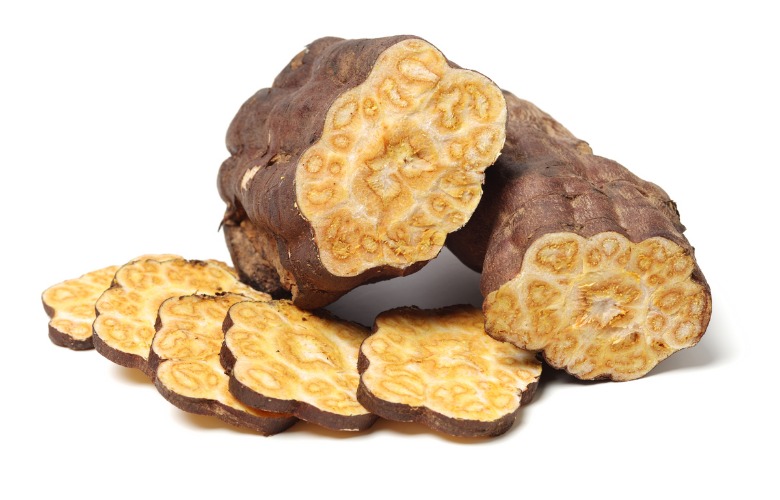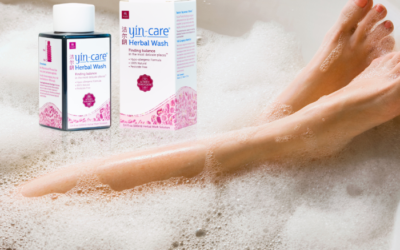Anti-Aging and Traditional Chinese Herbs
In these modern times the quest for youth has been revised to “anti-aging”. Turning back time is no longer required. What is an anti-aging herb? All herbs on this list are adaptogens. An adaptogen is defined in herbal medicine as “a natural substance considered to help the body adapt to stress and to exert a normalizing effect upon bodily processes.” Ginseng is a well-known adaptogen. Adaptogens contribute to anti-aging by minimizing the damage originating outside the body and maintaining balance within.
Come into the herb pharmacy and take a look at 4 anti-aging herbs. Each is categorized as an adaptogen yet have their own unique characteristics.

He Shou Wu
Translation: “Black Haired Mr. He”
Botanical name: Polygonum multiflorum
Part used: aged and prepared root
The upper part of He Shou Wu is a handsome vine with elongated heart-shaped leaves and delicate white bell-shaped flowers. The root, once extracted from the earth, is large bulbous affair. In Traditional Chinese Medical terms, He Shou Wu is used to tonify the Liver, Kidneys, Jing, and Blood. All of which tend to decline with age. This herb’s specialty is returning color to prematurely greying hair. Other indications for use are back and knee weakness, insomnia, and constipation(1). A dig into the modern research shows more sides of this useful root. He Shou Wu increases the cellular antioxidants SOD and glutathione peroxidase. Antioxidants protect cells from oxidation. Oxidation damages essential cell structure and is linked to aging (2). When damaged from a cardiac event, injury or chronic excessive exertion, the heart muscle heals itself. This healing is imperfect and is called “remodeling”. A decreased function is often the result of “remodeling”. Extracts of He Shou Wu protect the heart from “remodeling” during the healing process (3). He Shou Wu protects the brain from glutamate toxicity. Glutamate sends signals between nerve cells. It accumulates under stress. Glutamate toxicity is linked to Alzheimer’s (4). He Shou Wu raises levels of glycogen stores in the liver(1). This helps with sleep. Glycogen ensures that sleep will not be broken by the release of adrenaline from low blood sugar. Can He Shou Wu really help with hair color? There’s a good chance it can. It increases antioxidants to combat oxidation. Oxidative stress occurs when free radicals from pollution, poor diet, and stress outnumber the antioxidants. Graying hair is connected to damage from oxidative stress (5)(6)(7).
Caution: Not the best choice for weak digestion or phlegm conditions. Use the aged and processed root. The raw root can be toxic to the liver.

Reishi
Ling Zhi
Translation: “Spiritual Herb”
Botanical name: Ganoderma Lucida
Other Names: Mushroom of Immortality, Ten Thousand Year Old Mushroom
English names: glossy Ganoderma, shiny Polyporus.
Part Used: fruiting body (above-ground part)
Reishi or Ling Zhi mushroom has no gills. When fresh it is soft with a conspicuous red-varnished, kidney-shaped cap (6). 2400 years ago the near-mythic herbalist Shen Nong classified Ling Zhi as a “Superior Herb”. This category can be taken continuously without side effects. Shen Nong wrote of this mushroom “it makes your body light and young, lengthens your life and turns you into one like the immortal, who never dies.” Reishi often called “the mushroom of spiritual potency” by Taoist adepts and spiritual seekers.
The research on this fungus is compelling. Reishi presents as being anti-breast tumor in two studies (7)(8). One shows an epigenetic effect for inflammatory breast cancer (IBC). This is a rare aggressive form of breast cancer. Reishi down regulates certain proteins thereby reducing tumor growth(8). Other cancers which Reishi has an effect on are multiple myeloma, leukemia, Lymphoma, and prostate (9)(10)(11). In the case of multiple myeloma Reishi contains a molecule which inhibits the signaling pathway linked with this disease. In the cases of both leukemia and lymphoma Reishi caused cancer cell death.
Reishi has been used in China for hundreds of years to treat palpitations, restlessness, and insomnia. It nourishes the Heart and the Shen (mind). These actions have a calming effect. Sleep is our built-in healer and Reishi helps us get a little more. A rat study shows Reishi use helps rats sleep longer (12). Perhaps it is this relaxing quality that led the ancient Chinese to use Reishi to enhance spiritual and meditative practices.
Caution: Bleeding disorders, blood thinners, pregnancy

Rhodiola
hóng jǐng tiān
Botanical name: Rhodiola Rosea
Other Names: golden root, roseroot, roseroot, Aaron’s rod, Arctic root, king’s crown
Part Used: root
Rhodiola rosea grows in the Arctic and cold high altitude regions of Europe and Asia. Technically a ground cover, the plant sports yellow flowers, and fleshy green ovoid leaves. Rhodiola is unusual in that it is dioecious; plants are either male or female. The cut root smells like a rose, hence one of the common names: Rose Root.
Used by Vikings, Tibetan sherpas, and Chinese emperors. Rhodiola is in the Tibetan Materia Medica and that of the Greek physician Dioscorides (AD 40-90). Traditionally this root is used to treat for fatigue, anxiety, depression, and altitude sickness. In central Asia Rhodiola is regarded as an effective treatment for colds and flus .
Although it can’t makes you look like you did in high school, Rhodiola does help reduce belly fat. Rhodiola contains an active compound called rosavin which triggers a fat-burning response. In a study rats got fat from eating too much. When they were given extracts of Rhodiola and orange peel they lost some white belly fat (13). Cortisol causes belly fat as well and Rhodiola helps reduces that stress hormone. A 2009 Swedish study showed Rhodiola decreases cortisol response in patients with stress-related fatigue; a high cortisol condition. At the end of the 4-week study, Rhodiola participants had lower cortisol levels than the placebo. They also scored better on scales of burnout and cognitive function. The conclusion was that Rhodiola restores the normal sensitivity of cortisol receptors(14) . This removes excess cortisol out of the bloodstream. Excess cortisol causes a variety of symptoms anxiety, depression, insomnia, gut bacteria imbalance, high blood pressure……It’s a long list. Other studies show Rhodiola reduces mental fatigue and increases cognitive function (15)(16). The environment where a plant flourishes can instill an evolutionary adaption that is passed on to the consumer. As a high altitude plant, Rhodiola has adapted to more cosmic radiation than lower altitudes. Research shows Rhodiola does protect against radiation(17).
Caution: Rhodiola can cause caffeine-like jitters/anxiety in some people. Either decrease dosage or switch to another herb.

Ashwagandha
Botanical name: Withania somnifera
Translation: “Smell of Horse”
Other Names: Indian Ginseng, Winter Cherry
Part Used: root
At home in the drier parts of India, Ashwagandha is short shrub. Its dull green elliptical leaves are offset by small, green, bell-shaped flowers. Later in the growing cycle these dry to white and hold bright orange-red fruits. The root, which is the medicinal part, smells like a horse.
Ashwagandha has been a card-carrying member of the Ayurvedic materia medica for 3,000 years. Classified as a “life extender”, it is traditionally used to promote sleep, mental function, and endurance. Modern uses range from fertility to menopause, testosterone support to muscle building, and arthritis to diabetes . Research allows for a more tempered view. Ashwagandha does raise thyroid levels in the case of subclinical hypothyroid. (18)(19). High levels of cortisol inhibit the thyroid. This root has shown good results for lowering cortisol levels which are the result of stress (20). A rat study revealed that Ashwagandha protects brain cells from beta-amyloid-induced damage (21). Beta-Amyloid brain plaque contributes to Alzheimers.
Caution: Pregnancy. Although Ashwagandha is traditionally used for insomnia it can too heating for some individuals and cause insomnia. Do not use if digestive upset occurs.
Serving size for all herbal supplements: Consume according to the label on your product or as recommended by your healthcare practitioner.
Disclaimer
Use herbs wisely. If you have questions or special considerations, work with your practitioner. If symptoms worsen or you have concerns, contact a knowledgeable practitioner. These statements have not been evaluated by the Food and Drug Administration. These products are not intended to diagnose, treat, cure or prevent any disease.
References
1 Chinese Herbal Medicine Materia Medica, Revised Edition, Bensky & Gamble, Eastland Press, 1993, page 328-329
2 Acta Pharmocologica Sinica, 2010 Apr. 31(4) 405-412 The Protective Effects of of Polygonum multiflorum stilbeneglycoside preconditioning in an ischemia/reperfusion model of HUVECs Li-ping Liu, Zhang-ping Liao, Dong Yin, Wei-dong Li, Dan Liu, Qing Li, Qi-ren Huang, Yao-fang Yang, Ming He
3 Biological and Pharmacological Activity Georg Thieme Verlag KG Stuttgart, New York, The Effect of 2,3,4′,5-Tetrahydroxystilbene-2-O-β-D-Glucoside on Pressure Overload-Induced Cardiac Remodeling in Rats and Its Possible Mechanism, Xiao Le Xu , Qiu Yan Zhu , Cheng Zhao, Fei Wang, Zhong Yin Zhou, Ya E Hu, Wei Zhang
4 Journal of Ethnopharmacology 2017 Jan 4;195:64-70. doi: 10.1016/j.jep.2016.12.001. Epub 2016 Dec 7. Neuroprotective effects of 2,3,5,4′-tetrahydoxystilbene-2-O-β-D-glucoside from Polygonum multiflorum against glutamate-induced oxidative toxicity in HT22 cells, Lee SY, Ahn SM, Wang Z, Choi YW, Shin HK, Choi BT.
5 International Journal of Trichology 2015 Jul-Sep;7(3):91-4. doi: 10.4103/0974-7753.167469. Assessment of Oxidative Stress in Patients with Premature Canities.
6 Daulatabad D, Singal A, Grover C, Sharma SB, Chhillar N. (6) Bioorganic Medical Chemistry Letter 2013 Sep 1;23(17):4801-5. Promotion effect of constituents from the root of Polygonum multiflorum on hair growth, Sun YN, Cui L, Li W, Yan XT, Yang SY, Kang JI, Kang HK, Kim YH.
7 Journal of Ethnopharmacology. 2011 May 17;135(2):369-75. Topical application of Polygonum multiflorum extract induces hair growth of resting hair follicles through upregulating Shh and β-catenin expression in C57BL/6 mice. Park HJ, Zhang N, Park DK.
8 Mushrooms Demystified, 2nd edition. David Arora (1986). Ten Speed Press
9 PLoS One 2013; 8(2): e57431.Anti-Tumor Effects of Ganoderma lucidum (Reishi) in Inflammatory Breast Cancer in In Vivo and In Vitro Models. Ivette J. Suarez-Arroyo, Raysa Rosario-Acevedo, Alexandra Aguilar-Perez, Pedro L. Clemente, Luis A. Cubano, Juan Serrano, Robert J. Schneider, and Michelle M. Martínez-Montemayor
10 Nutrition and Cancer 2011 Oct; 63(7): 1085–1094. Ganoderma lucidum (Reishi) Inhibits Cancer Cell Growth and Expression of Key Molecules in Inflammatory Breast Cancer Michelle M. Martínez-Montemayor, Raysa Rosario Acevedo, Elisa Otero-Franqui, Luis. A. Cubano, and Suranganie F. Dharmawardhane
11 BMC Cancer 2012 Inhibition of STAT3 signaling and induction of SHP1 mediate antiangiogenic and antitumor activities of ergosterol peroxide in U266 multiple myeloma cells Yun-Hee Rhee, Soo-Jin Jeong, Hyo-Jeong Lee, Hyo-Jung Lee, Wonil Koh, Ji Hoon Jung, Sun-Hee Kim and Kim Sung-Hoon
12 Leukemia Research 2006 Jul;30(7):841-8. Epub 2006 Jan 19. Ganoderma lucidum causes apoptosis in leukemia, lymphoma and multiple myeloma cells. Müller CI1, Kumagai T, O’Kelly J, Seeram NP, Heber D, Koeffler HP.
13 International Journal of Oncology 2004 May;24(5):1093-9. Ganoderma lucidum inhibits proliferation and induces apoptosis in human prostate cancer cells PC-3.Jiang J1, Slivova V, Valachovicova T, Harvey K, Sliva D.
14 Journal of Ethnopharmacology 2012 Feb 15;139(3):796-800. Extract of Ganoderma lucidum prolongs sleep time in rats Cui XY1, Cui SY, Zhang J, Wang ZJ, Yu B, Sheng ZF, Zhang XQ, Zhang YH.
15 Nutritional Research online 2013 May 8 Citrus aurantium and Rhodiola rosea in combination reduce visceral white adipose tissue and increase hypothalamic norepinephrine in a rat model of diet-induced obesity Jessica L. Verpeut Amy L. Walters, Nicholas T. Bello
16 Planta Med 2009 Feb;75(2):105-12. A randomised, double-blind, placebo-controlled, parallel-group study of the standardised extract shr-5 of the roots of Rhodiola sea in the treatment of subjects with stress-related fatigue. Olsson EM, von Scheele B, Panossian AG.
17 Phytomedicine 2003 Mar;10(2-3):95-105 A randomized trial of two different doses of a SHR-5 Rhodiola rosea extract versus placebo and control of capacity for mental work. Shevtsov VA, Zholus BI, Shervarly VI, et al.
18 Phytomedicine 2010 Jun;17(7):494-9. Double-blind, placebo-controlled, randomised study of single dose effects of ADAPT-232 on cognitive functions. Aslanyan G, Amroyan E, Gabrielyan E, Nylander M, Wikman G, Panossian A.
19 Molecular and Cellular Biochemistry vol. 273, 2005, pages 209-223. Evaluation of Radioprotective activities of Rhodiloa imbricatat Edgew – A High Altitude Plant,
Rajesh Arora, Raman Chawla, Ravinder Sagar, Jagdish Prasad, Surendar Singh, Raj Kumar, Ashok Sharma, Shikha Singh, Rakesh Kumar Sharma, Division of Radiopharmaceuticals and Radiation Biology, Institute of Nuclear Medicine and Allied Sciences, Delhi, India
20 Journal of Alternative Complementary Medicine 2018 Mar;24(3):243-248. Efficacy and Safety of Ashwagandha Root Extract in Subclinical Hypothyroid Patients: A Double-Blind, Randomized Placebo-Controlled Trial, Sharma AK, Basu I, Singh S.
21 Journal of Ayurvedic Integrative Medicine 2014 Oct-Dec; 5(4): 241–245. Subtle changes in thyroid indices during a placebo-controlled study of an extract of Withania somnifera in persons with bipolar disorder Jessica M. Gannon, Paige E. Forrest, and K. N. Roy Chengappa
22 Indian Journal of Psychological Medicine 2012 Jul-Sep; 34(3): 255–262. A Prospective, Randomized Double-Blind, Placebo-Controlled Study of Safety and Efficacy of a High-Concentration Full-Spectrum Extract of Ashwagandha Root in Reducing Stress and Anxiety in Adults, K. Chandrasekhar, Jyoti Kapoor, Sridhar Anishetty
23 Phytotherapy Research 2010, 24(6):859-63 Withanamides in Withania somnifera fruit protect PC-12 cells from beta-amyloid responsible for Alzheimer’s disease. Jayaprakasam B, Padmanabhan K, Nair MG.

A licensed acupuncturist since 1999, Diana lives and works in Santa Cruz, California. Her practice focuses on pain management, stress reduction, and creating health. A longtime friend of plants, she loves the herbal side of Traditional Chinese Medicine. Diana shares her herbal interests through writing and a card game she designed and illustrated: Herb Apocalypse*. Volunteer work includes The Rabbit Haven, a rabbit rescue, and Livity Rising, free community healing clinics. Author of Herb Apothecary: The Coloring Book: 54 Chinese Herbs available on Amazon.



